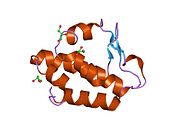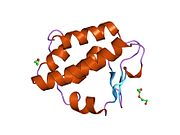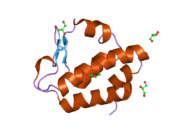Biology:NGLY1
 Generic protein structure example |
PNGase also known as N-glycanase 1 (EC 3.5.1.52) or peptide-N(4)-(N-acetyl-beta-glucosaminyl)asparagine amidase is an enzyme that in humans is encoded by the NGLY1 gene. PNGase is a de-N-glycosylating enzyme that removes N-linked or asparagine-linked glycans (N-glycans) from glycoproteins.[1][2][3] More specifically, NGLY1 catalyzes the hydrolysis of the amide bond between the innermost N-acetylglucosamine (GlcNAc) and an Asn residue on an N-glycoprotein, generating a de-N-glycosylated protein, in which the N-glycoylated Asn residue is converted to asp, and a 1-amino-GlcNAc-containing free oligosaccharide. Ammonia is then spontaneously released from the 1-amino GlcNAc at physiological pH (<8), giving rise to a free oligosaccharide with an N,N’-diacetylchitobiose structure at the reducing end.
Discovery
Occurrence of cytoplasmic PNGase activity in mammalian cells was first reported in cultured cells.[4] This enzyme differ from other “reagent” PNGases from almond (glycoamidase/PNGase A),[5] or bacteria (N-glycanase/PNGase F),[6] that is often used for structural/functional studies of N-glycans, in several enzymatic properties, including the requirement of a reducing reagent for activity and a neutral pH for optimal activity.[4][7][8]
The gene encoding the cytoplasmic PNGase was first identified in budding yeast, Saccharomyces cerevisiae and gene orthologues have since been found in wide variety of eukaryotes including mammals.[9] In terms of the tissue distribution of the mouse Ngly1 gene, enzyme activities as well as transcripts were detected in all tissues/organs examined.[8][10]
Structure
The catalytic residues of the cytoplasmic PNGase is known to reside in a domain called transglutaminase domain.[11][12] NGLY1, when compared with the yeast orthologues, possesses extended N-terminal and C-terminal sequences in addition to the transglutaminase domain. Among the additional domains found in NGLY1, the PUB (PNGase- and ubiquitin-related) domain was first identified through a bioinformatics analysis.[13][14] While it was initially hypothesized that it might serve as a protein-protein interaction domain,[13] experimental evidence supporting this hypothesis is now accumulating.[15][16][17] On the other hand, the C-terminal PAW domain (a domain present in PNGases and other worm proteins).[14] has now been shown to be involved in the binding of oligosaccharides to PNGase.[18]
In terms of the crystal structures of mouse Ngly1, a catalytic core domain,[19] a C-terminal domain including PAW domain[18] and an N-terminal domain including PUB domain.[20] have been obtained.
Function
Regarding the function of NGLY1, it has been shown that the enzyme is involved in the ER-associated degradation (ERAD), one of the ER quality control/homeostasis systems for newly synthesized glycoproteins.[21][22][23][24] The functional importance of NGLY1 in the ERAD process, however, is not clearly understood. It has also been suggested that NGLY1 is closely involved in MHC class I-mediated antigen presentation.[25][26][27] The Ngly1-mediated (glycosylated) Asn-to-Asp deamidation constitutes, together with other reactions such as transpeptidation, unconventional post-translational modifications for antigenic peptides that are presented by MHC class I molecules.[28]
NGLY1-binding proteins
Through yeast two-hybrid screening, it has been shown that NGLY1 proteins can bind to several proteins, mostly through the N-terminal domain including the PUB domain.[29] In vivo and in vitro interactions between NGLY1 and several ERAD-related proteins have been reported.[16][19][20][29][30][31][32][33][34] While the importance of those protein-protein interactions to NGLY1 functions remain to be clarified, it can be assumed that such interactions may be advantageous for an efficient ERAD process.[35]
Clinical significance
In 2012, NGLY1 deficiency, involving mutations in the NGLY1 gene locus was first identified through an exome analysis.[36] As of now, the clinical features of 60 patients have been reported in the literature and over 100 have been identified by patient advocacy groups.[37][38][39][40] One cerebral visual impairment (CVI) patient also had a mutation in NGLY1 gene.[41] The clinical effects include neuromotor impairment, intellectual disability, and neuropathy. It has also been associated with amyotrophic lateral sclerosis and Parkinson's disease.
Details of the mechanism responsible for the pathogenesis of the NGLY1-deficiency remains unknown, while the intracellular accumulation of N-GlcNAc proteins, due to the excess action of cytosolic endo-b-N-acetylglucosaminidase[42] to misfolded glycoproteins, in Ngly1-deficient cells has been hypothesized as a potential cause.[24]
NGLY1 deficiency has drawn attention in the public.[43][44][45][46]
Studies have been carried out to discover small-molecules that can bind to the transglutaminase domain of the protein to stabilize it as a potential therapeutic applications in the treatment of disorder caused by NGLY1 mutants.[47]
Notes
References
- ↑ "Physiological and molecular functions of the cytosolic peptide:N-glycanase". Seminars in Cell & Developmental Biology 41: 110–120. May 2015. doi:10.1016/j.semcdb.2014.11.009. PMID 25475175.
- ↑ "The cytoplasmic peptide:N-glycanase (Ngly1)-basic science encounters a human genetic disorder". Journal of Biochemistry 157 (1): 23–34. January 2015. doi:10.1093/jb/mvu068. PMID 25398991.
- ↑ "The cytoplasmic peptide:N-glycanase (NGLY1) - Structure, expression and cellular functions". Gene 577 (1): 1–7. February 2016. doi:10.1016/j.gene.2015.11.021. PMID 26611529.
- ↑ 4.0 4.1 "Identification of peptide:N-glycanase activity in mammalian-derived cultured cells". Biochemical and Biophysical Research Communications 194 (3): 1124–1130. August 1993. doi:10.1006/bbrc.1993.1938. PMID 8352768.
- ↑ "Demonstration of a new amidase acting on glycopeptides". Biochemical and Biophysical Research Communications 76 (4): 1194–1201. June 1977. doi:10.1016/0006-291x(77)90982-2. PMID 901470.
- ↑ "Demonstration of peptide:N-glycosidase F activity in endo-beta-N-acetylglucosaminidase F preparations". The Journal of Biological Chemistry 259 (17): 10700–10704. September 1984. doi:10.1016/S0021-9258(18)90568-5. PMID 6206060.
- ↑ "Purification and enzymatic properties of peptide:N-glycanase from C3H mouse-derived L-929 fibroblast cells. Possible widespread occurrence of post-translational remodification of proteins by N-deglycosylation". The Journal of Biological Chemistry 269 (26): 17611–17618. July 1994. doi:10.1016/S0021-9258(17)32485-7. PMID 8021270.
- ↑ 8.0 8.1 "Identification and distribution of peptide:N-glycanase (PNGase) in mouse organs". Archives of Biochemistry and Biophysics 319 (2): 393–401. June 1995. doi:10.1006/abbi.1995.1309. PMID 7786020.
- ↑ "PNG1, a yeast gene encoding a highly conserved peptide:N-glycanase". The Journal of Cell Biology 149 (5): 1039–1052. May 2000. doi:10.1083/jcb.149.5.1039. PMID 10831608.
- ↑ "Ngly1, a mouse gene encoding a deglycosylating enzyme implicated in proteasomal degradation: expression, genomic organization, and chromosomal mapping". Biochemical and Biophysical Research Communications 304 (2): 326–332. May 2003. doi:10.1016/s0006-291x(03)00600-4. PMID 12711318.
- ↑ "A superfamily of archaeal, bacterial, and eukaryotic proteins homologous to animal transglutaminases". Protein Science 8 (8): 1714–1719. August 1999. doi:10.1110/ps.8.8.1714. PMID 10452618.
- ↑ "Site-directed mutagenesis study of yeast peptide:N-glycanase. Insight into the reaction mechanism of deglycosylation". The Journal of Biological Chemistry 277 (15): 12953–12959. April 2002. doi:10.1074/jbc.M111383200. PMID 11812789.
- ↑ 13.0 13.1 "The PUB domain: a putative protein-protein interaction domain implicated in the ubiquitin-proteasome pathway". Biochemical and Biophysical Research Communications 287 (5): 1083–1087. October 2001. doi:10.1006/bbrc.2001.5688. PMID 11587532.
- ↑ 14.0 14.1 "Systematic identification of novel protein domain families associated with nuclear functions". Genome Research 12 (1): 47–56. January 2002. doi:10.1101/gr.203201. PMID 11779830.
- ↑ "The PUB domain functions as a p97 binding module in human peptide N-glycanase". The Journal of Biological Chemistry 281 (35): 25502–25508. September 2006. doi:10.1074/jbc.M601173200. PMID 16807242.
- ↑ 16.0 16.1 "NMR characterization of the interaction between the PUB domain of peptide:N-glycanase and ubiquitin-like domain of HR23". FEBS Letters 586 (8): 1141–1146. April 2012. doi:10.1016/j.febslet.2012.03.027. PMID 22575648.
- ↑ "Binding of OTULIN to the PUB domain of HOIP controls NF-κB signaling". Molecular Cell 54 (3): 349–361. May 2014. doi:10.1016/j.molcel.2014.03.016. PMID 24726327.
- ↑ 18.0 18.1 "Structural and biochemical studies of the C-terminal domain of mouse peptide-N-glycanase identify it as a mannose-binding module". Proceedings of the National Academy of Sciences of the United States of America 103 (46): 17214–17219. November 2006. doi:10.1073/pnas.0602954103. PMID 17088551. Bibcode: 2006PNAS..10317214Z.
- ↑ 19.0 19.1 "Structure of the mouse peptide N-glycanase-HR23 complex suggests co-evolution of the endoplasmic reticulum-associated degradation and DNA repair pathways". The Journal of Biological Chemistry 281 (19): 13751–13761. May 2006. doi:10.1074/jbc.M600137200. PMID 16500903.
- ↑ 20.0 20.1 "Studies on peptide:N-glycanase-p97 interaction suggest that p97 phosphorylation modulates endoplasmic reticulum-associated degradation". Proceedings of the National Academy of Sciences of the United States of America 104 (21): 8785–8790. May 2007. doi:10.1073/pnas.0702966104. PMID 17496150. Bibcode: 2007PNAS..104.8785Z.
- ↑ "The human cytomegalovirus US11 gene product dislocates MHC class I heavy chains from the endoplasmic reticulum to the cytosol". Cell 84 (5): 769–779. March 1996. doi:10.1016/s0092-8674(00)81054-5. PMID 8625414.
- ↑ "A role for N-glycanase in the cytosolic turnover of glycoproteins". The EMBO Journal 22 (5): 1036–1046. March 2003. doi:10.1093/emboj/cdg107. PMID 12606569.
- ↑ "Deglycosylation-dependent fluorescent proteins provide unique tools for the study of ER-associated degradation". Proceedings of the National Academy of Sciences of the United States of America 110 (9): 3393–3398. February 2013. doi:10.1073/pnas.1300328110. PMID 23401531. Bibcode: 2013PNAS..110.3393G.
- ↑ 24.0 24.1 "Endo-β-N-acetylglucosaminidase forms N-GlcNAc protein aggregates during ER-associated degradation in Ngly1-defective cells". Proceedings of the National Academy of Sciences of the United States of America 112 (5): 1398–1403. February 2015. doi:10.1073/pnas.1414593112. PMID 25605922. Bibcode: 2015PNAS..112.1398H.
- ↑ "An HLA-A2-restricted tyrosinase antigen on melanoma cells results from posttranslational modification and suggests a novel pathway for processing of membrane proteins". The Journal of Experimental Medicine 183 (2): 527–534. February 1996. doi:10.1084/jem.183.2.527. PMID 8627164.
- ↑ "Processing of a class I-restricted epitope from tyrosinase requires peptide N-glycanase and the cooperative action of endoplasmic reticulum aminopeptidase 1 and cytosolic proteases". Journal of Immunology 177 (8): 5440–5450. October 2006. doi:10.4049/jimmunol.177.8.5440. PMID 17015730.
- ↑ "N-linked glycosylation does not impair proteasomal degradation but affects class I major histocompatibility complex presentation". The Journal of Biological Chemistry 283 (1): 244–254. January 2008. doi:10.1074/jbc.M706237200. PMID 17951257.
- ↑ "An antigenic peptide produced by reverse splicing and double asparagine deamidation". Proceedings of the National Academy of Sciences of the United States of America 108 (29): E323–E331. July 2011. doi:10.1073/pnas.1101892108. PMID 21670269. Bibcode: 2011PNAS..108E.323D.
- ↑ 29.0 29.1 "Identification of proteins that interact with mammalian peptide:N-glycanase and implicate this hydrolase in the proteasome-dependent pathway for protein degradation". Proceedings of the National Academy of Sciences of the United States of America 98 (20): 11163–11168. September 2001. doi:10.1073/pnas.201393498. PMID 11562482. Bibcode: 2001PNAS...9811163P.
- ↑ "A novel UBA and UBX domain protein that binds polyubiquitin and VCP and is a substrate for SAPKs". The Biochemical Journal 384 (Pt 2): 391–400. December 2004. doi:10.1042/BJ20041498. PMID 15362974.
- ↑ "A complex between peptide:N-glycanase and two proteasome-linked proteins suggests a mechanism for the degradation of misfolded glycoproteins". Proceedings of the National Academy of Sciences of the United States of America 101 (38): 13774–13779. September 2004. doi:10.1073/pnas.0405663101. PMID 15358861. Bibcode: 2004PNAS..10113774K.
- ↑ "The retrotranslocation protein Derlin-1 binds peptide:N-glycanase to the endoplasmic reticulum". Molecular Biology of the Cell 16 (10): 4584–4594. October 2005. doi:10.1091/mbc.E05-04-0345. PMID 16055502.
- ↑ "Multiple modes of interaction of the deglycosylation enzyme, mouse peptide N-glycanase, with the proteasome". Proceedings of the National Academy of Sciences of the United States of America 102 (44): 15809–15814. November 2005. doi:10.1073/pnas.0507155102. PMID 16249333. Bibcode: 2005PNAS..10215809L.
- ↑ "The AAA ATPase p97 links peptide N-glycanase to the endoplasmic reticulum-associated E3 ligase autocrine motility factor receptor". Proceedings of the National Academy of Sciences of the United States of America 103 (22): 8348–8353. May 2006. doi:10.1073/pnas.0602747103. PMID 16709668. Bibcode: 2006PNAS..103.8348L.
- ↑ "Hypothesis: a glycoprotein-degradation complex formed by protein-protein interaction involves cytoplasmic peptide:N-glycanase". Biochemical and Biophysical Research Communications 302 (1): 1–5. February 2003. doi:10.1016/s0006-291x(03)00052-4. PMID 12593838.
- ↑ "Clinical application of exome sequencing in undiagnosed genetic conditions". Journal of Medical Genetics 49 (6): 353–361. June 2012. doi:10.1136/jmedgenet-2012-100819. PMID 22581936.
- ↑ "Delineating the epilepsy phenotype of NGLY1 deficiency". Journal of Inherited Metabolic Disease 45 (3): 571–583. March 2022. doi:10.1002/jimd.12494. PMID 35243670.
- ↑ "Mutations in NGLY1 cause an inherited disorder of the endoplasmic reticulum-associated degradation pathway". Genetics in Medicine 16 (10): 751–758. October 2014. doi:10.1038/gim.2014.22. PMID 24651605.
- ↑ "NGLY1 mutation causes neuromotor impairment, intellectual disability, and neuropathy". European Journal of Medical Genetics 58 (1): 39–43. January 2015. doi:10.1016/j.ejmg.2014.08.008. PMID 25220016.
- ↑ "Multi-systemic involvement in NGLY1-related disorder caused by two novel mutations". American Journal of Medical Genetics. Part A 167A (4): 816–820. April 2015. doi:10.1002/ajmg.a.36889. PMID 25707956.
- ↑ "Novel genetic causes for cerebral visual impairment". European Journal of Human Genetics 24 (5): 660–665. May 2016. doi:10.1038/ejhg.2015.186. PMID 26350515.
- ↑ "Endo-beta-N-acetylglucosaminidase, an enzyme involved in processing of free oligosaccharides in the cytosol". Proceedings of the National Academy of Sciences of the United States of America 99 (15): 9691–9696. July 2002. doi:10.1073/pnas.152333599. PMID 12114544. Bibcode: 2002PNAS...99.9691S.
- ↑ "Kids who don't cry: New genetic disorder discovered". 20 March 2014. http://edition.cnn.com/2014/03/20/health/ngly1-genetic-disorder/.
- ↑ "One of a Kind". The New Yorker. 14 July 2014. http://www.newyorker.com/reporting/2014/07/21/140721fa_fact_mnookin.
- ↑ "Hunting down my son's killer". http://matt.might.net/articles/my-sons-killer/.
- ↑ "The shifting model in clinical diagnostics: how next-generation sequencing and families are altering the way rare diseases are discovered, studied, and treated". Genetics in Medicine 16 (10): 736–737. October 2014. doi:10.1038/gim.2014.23. PMID 24651604.
- ↑ "Novel small molecule binders of human N-glycanase 1, a key player in the endoplasmic reticulum associated degradation pathway". Bioorganic & Medicinal Chemistry 24 (19): 4750–4758. October 2016. doi:10.1016/j.bmc.2016.08.019. PMID 27567076.
This article incorporates text from the United States National Library of Medicine, which is in the public domain.






